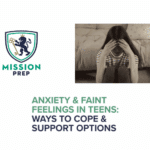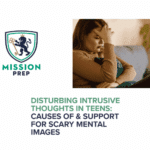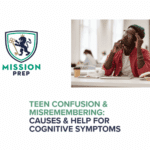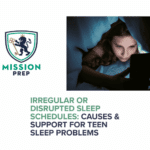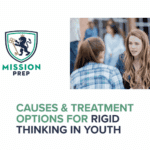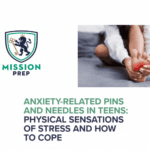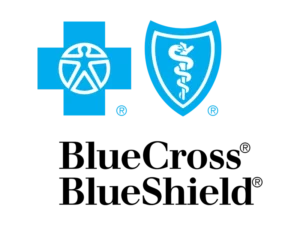OCD Signs in Teenagers: How to Tell if a Teen Has OCD & When to Seek Support

OCD often conjures the image of someone excessively handwashing or keeping things in perfect order. But OCD in teenagers can look quite different. If your teen seems to get stuck in mental loops, endless routines, or persistent intrusive thoughts, they may be silently struggling.
Obsessive-compulsive disorder (OCD) frequently begins in youth, but can be continually misunderstood and worsen over time. It’s not simply a teenager’s personality “quirk” – it’s a mental health condition that can be effectively treated.
A mental health professional, such as a therapist, can give your teen the support and treatment they need. This page can help you recognize the early warning signs of OCD and when to seek support from a professional.
On this page, you’ll explore:
- What OCD is
- Early warning signs of OCD in teens
- Symptoms of OCD in adolescents
- Compulsions vs. “normal” habits
- How OCD can impact school and daily life
- Where to seek professional help

What Is OCD in Teenagers?
According to the American Academy of Child & Adolescent Psychiatry (AACAP), OCD involves “recurrent intense obsessions and/or compulsions that cause severe distress and interfere with day-to-day functioning.”4
The following sections explore obsessions and compulsions in more detail.
Teenage Intrusive Thoughts
Obsessions are repetitive, unwanted thoughts or images that cause distress, anxiety, or fear. These thoughts may be completely irrational or have no real basis, yet this doesn’t diminish the impact they often have. They could even be compared to having a fire alarm in your head that triggers whenever you toast bread. There’s no real threat, but the alarm reacts as though there is.
Often, the theme of obsessions may be related to something a teen places a high value on in their life. This is what can make obsessions so disturbing.5 In fact, it is thought that OCD in teens may manifest as obsessions specifically linked to this time in their lives, such as sexuality, school work, and social dynamics.6
To help you understand the form that obsessions can take, we cover a few examples in the next section.
Examples of Obsessions
Obsessions can be generally grouped into certain categories, such as:7,8
Sexual: Experiencing disturbing, unwanted thoughts or images relating to sex, such as sexually harming others or acting on sexual impulses- Religious or moral: A fear relating to religion or morality, such as a fear of offending God, or excessively worrying about “right and wrong”
- Perfectionism: Being overly concerned about things being perfect, such as needing order or a fear of making mistakes
- Identify: An excessive concern regarding aspects of identity, for example, gender or sexual orientation
- Contamination: Fear of coming into contact with germs, bodily fluids, dirt, and so on
- Responsibility: Fearing that you will be responsible for something awful happening to yourself or others
- Violence: Feeling scared of acting out a violent impulse, for instance, harming yourself or others
- Other: Obsessions can also be linked to other themes, such as relationships, false memories, or death
Compulsive Rituals in Teens
To ease the discomfort that obsessions bring, a teen may feel compelled to perform certain actions. These behaviors are known as compulsions or “rituals,” and can bring a temporary relief from the distress caused by obsessions.
Sometimes, rituals may seem to make sense as a response to an intrusive thought. For instance, a person with a fear of germs might compulsively wash their hands. However, in other circumstances, compulsions may appear to have no link at all to an obsession.
Whether or not a ritual seems to be intuitively linked with the obsession, it’s important to remember that teens don’t get any pleasure from performing compulsions. Rituals are often time-consuming, but without another way to relieve the anxiety that results from obsessions, teens with OCD typically feel incapable of stopping them.
In the next section, we provide some examples of rituals to help you recognize signs of obsessive compulsive disorder in young adults.
Examples of Compulsions
Compulsions may take many ritualistic forms, often presenting as:7
Mental rituals: Such as praying to prevent harm, counting numbers, or repeating a certain phrase silently to “undo” a bad thought- Reassurance seeking: Repeatedly asking for consolation that things are “OK”
- Checking: For example, excessively going over assignments to ensure no mistakes were made
- Cleaning: For instance, washing hands excessively or cleaning objects
- Repetitions: Actions such as flicking light switches on and off or doing activities a set number of times
- Other: Rituals can also present themselves in other ways, including putting things in order, performing a behavior until it “feels right,” or avoiding triggering situations
If you recognize some of these compulsions or obsessions, they may be OCD mental health warning signs in adolescents. The following sections will discuss some of the early OCD signs in teenagers to watch for, as well as symptoms that may signal the need for professional support.
Early Signs of OCD in Teens
OCD in teenagers has the potential to severely impact their daily lives. Because of this, knowing the early warning signs of OCD can be invaluable in getting a teen the timely support they need.
OCD doesn’t suddenly appear overnight. It frequently starts with small shifts in behavior, thoughts, or emotional reactions. However, sometimes, these early signs may be overlooked or written off as “teenage moodiness” or a change in habits as they grow older. Let’s take a look at some of these early OCD “red flags.”
Early OCD Red Flags in Youth
Understandably, obsessive, intrusive thoughts can be an early sign of OCD. For example, a teen may notice a repetitive “odd” thought that causes them to feel worried again and again. The thought may come out of the blue and feel impossible to shift attention away from.
Additionally, teens may attempt to hide symptoms due to embarrassment or shame. For instance, adolescents might have obsessions centered around sexual, moral, or religious themes, which may be considered “taboo” subjects. This also means compulsions may appear less obvious, such as confessing, apologizing for actions, or excessively asking for reassurance.2
Furthermore, some symptoms, such as perfectionism, can be unknowingly reinforced by parents and teachers. For example, if the teen is a good student and praised for their “hard-working” attitude.2 A need for control or for something to feel “right” when checking homework could also be mistaken for diligence.
These early behaviors may not seem like a serious concern at first glance, yet they can become more intense over time as OCD develops. Therefore, noticing these red flags, especially if they cause your teen distress, can be crucial in supporting their mental health.
In the next section, we walk through a checklist of common OCD symptoms in adolescents.
Teenage OCD Symptoms Checklist
Experiencing obsessions, compulsions, or both, on most days- Spending over an hour a day on obsessions or rituals
- Obsessions or compulsions becoming repetitive and unpleasant, and causing distress
- Feeling unable to control obsessions or compulsions
- Not obtaining pleasure from compulsions, other than feeling only a short-lived sense of relief
- Avoiding situations that may trigger obsessions or compulsions
- Experiencing problems in daily life due to obsessions or compulsions
Given that teens may try to hide their compulsions, some examples of subtle behaviors that may indicate symptoms of OCD include:12
Avoiding touching surfaces that others have touched- Refusing to use public bathrooms
- Withdrawing from other people
- Avoiding playing contact sports for fear of contamination
- Not wanting to share things with others
- Appearing anxious
- Becoming upset or frustrated when their routine is disrupted
- Not wanting to eat in the school cafeteria
- Becoming obsessed with their romantic relationship (relationship OCD)
- Re-reading pages of a book
- Constantly rechecking that everything is in place, such as checking their backpack repeatedly
If some of these signs strike a chord, your teen may be displaying signs of OCD. However, some teens and children may have similar behaviors that are normal for their circumstances and not indicative of OCD. The section below compares teen OCD vs normal habits to help clarify these.
Compulsive Behaviors in Adolescents vs. Normal Teenage Habits
It’s entirely normal for teenagers to have their own preferences and habits as they grow older. Yet, sometimes, these behaviors can be confused for OCD. For instance, they may like to have a tidy bedroom, or do a quick double-check of their homework before submitting it.
Yet normal habits tend to have some flexibility and don’t cause much distress if routines are disrupted. In fact, some adolescents thrive on routines and enjoy the predictability they can provide.
In contrast, when it comes to OCD in teenagers, habits aren’t flexible or enjoyable. These compulsions or rituals are things a teen feels they must do to relieve their distress.
It may help to illustrate the differences between OCD and typical behaviors with a few examples:
Typical teen behavior: Liking to keep their room clean and tidy
Possible compulsion: Feeling very anxious if one thing is out of place
Typical teen behavior: Re-checking homework once or twice
Possible compulsion: Checking homework repeatedly until it feels “just right”
Typical teen behavior: Enjoying having routines
Possible compulsion: Becoming extremely distressed if their rituals or routines are interrupted in any way
The anxiety and distress experienced when a compulsion can’t be completed is one of the key emotional symptoms of OCD teens face. If your teen becomes deeply upset when they can’t complete their routine, it may be time to discuss the signs of OCD with them. Although they may be embarrassed to talk about the specifics of obsessions or compulsions, they might be able to indicate whether the core features of OCD resonate with them.
Impact of OCD in Teenagers
Living with OCD as a teen can affect every area of life, from friendships to school, relationships, and mental health. We break down these potential impacts below to help increase understanding.
OCD Symptoms School Impact
OCD in teenagers may affect their schoolwork. This may be due to lengthy rituals causing a student to be late, or obsessions interrupting their concentration in class. Additionally, if a teen is embarrassed by their compulsions but feels unable to adequately hide them, they may choose to withdraw from socializing so they won’t be “found out.”12
OCD and Relationships
Obsessions and compulsions not only take up a lot of mental space, but they can be time-consuming as well as deeply distressing. Because of this, OCD can affect a teen’s family dynamics, friendships, or romantic relationships. Withdrawal from others can also cause feelings of confusion and hurt, impacting bonds.
Impact on Mental and Emotional Health
Anxiety, distress, shame, and embarrassment caused by intrusive thoughts or rituals are all mental health symptoms OCD teens may struggle with. Research also shows that teens living with OCD are at a higher risk of developing anxiety disorders as adults.13 Plus, without help and support, mental health issues can worsen over time and continue into adulthood.
If you’re a parent wondering when to seek help for teen OCD, know that although early intervention is recommended, it’s never too late to get someone the support they need. OCD is a treatable mental health condition, and with the right professional support and guidance, they can begin living a life without the heavy weight of compulsions and distressing obsessions.

Healing OCD With Mission Prep
Witnessing your teen struggle with OCD can feel overwhelming, but help is available.
At Mission Prep, we specialize in treating teens with OCD. We create personalized treatment plans offering a combination of evidence-based therapy (including ERP) and medication management when appropriate. Our team can also offer residential, outpatient, and virtual treatment options, ensuring we can support your family’s needs and your teen’s schedule in the most appropriate ways.
Whether your teen is showing early signs of OCD or needs a more intense level of support, we’re here to help. Reach out to us today to discover how we can support your teen’s journey to healing.
References
- Millet, B., Kochman, F., Gallarda, T., Krebs, M. O., Demonfaucon, F., Barrot, I., Hantouche, E. G. (2004). Phenomenological and comorbid features associated in obsessive–compulsive disorder: influence of age of onset. Journal of affective disorders, 79(1-3), 241-246.
- Geller, D. A., Homayoun, S., & Johnson, G. (2021). Developmental Considerations in Obsessive Compulsive Disorder: Comparing Pediatric and Adult-Onset Cases. Frontiers in psychiatry, 12, 678538. https://doi.org/10.3389/fpsyt.2021.678538
- Browne, H. A., Hansen, S. N., Buxbaum, J. D., Gair, S. L., Nissen, J. B., Nikolajsen, K. H., Schendel, D. E., Reichenberg, A., Parner, E. T., & Grice, D. E. (2015). Familial clustering of tic disorders and obsessive-compulsive disorder. JAMA psychiatry, 72(4), 359–366. https://doi.org/10.1001/jamapsychiatry.2014.2656
- AACAP. (n.d.). Obsessive Compulsive Disorder Resource Center. Retrieved September 8, 2025. https://www.aacap.org/aacap/Families_and_Youth/Resource_Centers/Obsessive_Compulsive_Disorder_Resource_Center/Home.aspx
- Anxiety and Depression Association of America (ADAA). (2025, August 20). Obsessive-Compulsive Disorder (OCD) https://adaa.org/understanding-anxiety/co-occurring-disorders/obsessive-compulsive-disorder
- Webb, J. (2025, August 28). OCD in Teens: Signs, symptoms, and treatment. NOCD. https://www.treatmyocd.com/blog/ocd-teen-symptoms-signs-how-to-treat-erp
- International OCD Foundation. (2025, February 5). All there is to know about OCD. https://iocdf.org/about-ocd/
- Clark, D. A., & Radomsky, A. S. (2014). Introduction: A global perspective on unwanted intrusive thoughts. Journal of Obsessive-Compulsive and Related Disorders, 3(3), 265–268. https://doi.org/10.1016/j.jocrd.2014.02.001
- National Institute of Mental Health (NIMH). (2023). Obsessive-Compulsive disorder: when unwanted thoughts or repetitive behaviors take over. https://www.nimh.nih.gov/health/publications/obsessive-compulsive-disorder-when-unwanted-thoughts-or-repetitive-behaviors-take-over
- Mayo Clinic. (2023, December 21). Obsessive-compulsive disorder (OCD) – Symptoms and causes.
- Krebs, G., & Heyman, I. (2014). Obsessive-compulsive disorder in children and adolescents. Archives of Disease in Childhood, 100(5), 495–499. https://doi.org/10.1136/archdischild-2014-306934
- Anxiety and Depression Association of America, ADAA. (n.d.). OCD at school. Retrieved September 8, 2025. https://adaa.org/understanding-anxiety/obsessive-compulsive-disorder/ocd-at-school
- Lewin, A. B., Chang, S., McCracken, J., McQueen, M., & Piacentini, J. (2010). Comparison of clinical features among youth with tic disorders, obsessive–compulsive disorder (OCD), and both conditions. Psychiatry Research, 178(2), 317–322. https://doi.org/10.1016/j.psychres.2009.11.013

